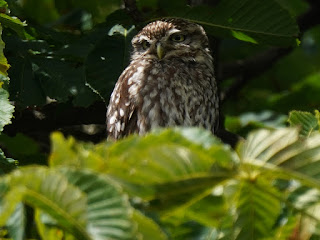I hope you aren't getting bored with Little Owls, as to me they are a source of endless delight. Today I saw eight of them.
This is the male near the Round Pond on the dead tree where the pair nested ...
... and here are his mate ...
... and one of the owlets.
This video shows the complete family: the male on the nest tree with one of the owlets looking out of another hole at the top, the female in a horse chestnut tree, and the other two owlets in different horse chestnuts.
Cindy Chen captured this splendid shot of the male in flight.
At the Serpentine Gallery, the female has taken to perching on the sweet chestnut tree next to the one where she nested, which keeps her a reasonable distance from the incessantly demanding owlets.
They were both on the nest tree, begging loudly.
Only the male isn't showing up, and as far as I know no one has seen him. I'm sure he's around, as it takes two parents to keep two hungry owlets fed with worms and beetles. Probably he has a favourite perch on a nearby tree that we haven't found.
A Long-Tailed Tit paused for a moment on a dead tree near the bridge.
Mark Williams sent this pleasing picture of two young Jays.
An elderly and faded Carrion Crow took it easy on a concrete bench at the Dell restaurant.
A crow near the leaf yard enjoyed a bit of apple stolen from the people feeding the parakeets, but was bothered by a Wood Pigeon which got part of his food.
Farther up the hill, a couple of crows harassed a Grey Heron perched on the fence, forcing it to fly away.
Many of the moulting geese have now completely regrown their wing feathers and are airworthy again. You can see the new primaries crossed over this Greylag's tail.
Honeybees collected nectar and pollen from a cardoon flower -- an odd thing halfway between a thistle and an artichoke.
A Common Carder Bee browsed on a Bird's-Foot Trefoil flower.
This is a still taken from a video I put up on Sunday. I identified the bee as a Honeybee, but Duncan Campbell points out that it isn't, and its bold stripes indicate a different species. Can anyone identify it?
Another puzzle: a bundle of web about a foot long in a hawthorn tree near the Rose Garden. Clearly it encloses some kind of larvae that are feeding on the leaves inside, but it isn't like the all-enveloping webs of Ermine Micromoths that are seen covering bushes in Hyde Park. Does anyone know what made it?
Update: Mario think it's the Hawthorn Moth, Scythropia crataegella, though he can't be certain just from a photograph.



%202022%201a.jpg)




%202022%201a.jpg)






That's an excellent number of Little Owls! Who could fail to be charmed by them?
ReplyDeleteDifficult to be sure about the webbing without seeing larvae-Lackey might be a possibility?
The numerous little black dots inside the web didn't seem to be moving -- unlike the Ermine Micromoth larvae which could be seen chewing up the unfortunate bush. I've never seen anything like this before.
DeleteMy guess would be the Hawthorn Moth - Scythropia crataegella. I think I can see the caterpillars behind the webbing on the right of the photo. The black dots are unlikely to move, as I think they are just the caterpillar's poo
DeleteMany thanks for the identification. I'll put a note on the blog, mentioning that it's not certain.
DeleteWonderful photos. I have a meeting at the Natural History Museum Saturday and am hoping to go and the see the little owls beforehand. Can you give me any advice please?
ReplyDeleteI'm not putting the locations on the blog. Please write to me.
DeleteThere can never be too many owls. What would we do without them?
ReplyDeleteHow old may that crow be? It does look very frail.
Tinúviel
According to Esther Woolfson, author of Corvus, the lifespan of a crow is 14 years.
Delete